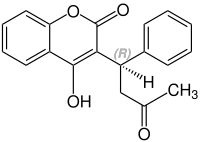Warfarin
| Structural formula | |||||||||||||
|---|---|---|---|---|---|---|---|---|---|---|---|---|---|

|
|||||||||||||
| Structural formula without stereochemistry | |||||||||||||
| General | |||||||||||||
| Non-proprietary name | Warfarin | ||||||||||||
| other names |
( RS ) -4-Hydroxy-3- (3-oxo-1-phenyl-butyl) -coumarin ( IUPAC ) |
||||||||||||
| Molecular formula | C 19 H 16 O 4 | ||||||||||||
| Brief description |
colorless and odorless solid |
||||||||||||
| External identifiers / databases | |||||||||||||
|
|||||||||||||
| Drug information | |||||||||||||
| ATC code | |||||||||||||
| Drug class | |||||||||||||
| properties | |||||||||||||
| Molar mass | 308.33 g · mol -1 | ||||||||||||
| Physical state |
firmly |
||||||||||||
| Melting point |
161 ° C |
||||||||||||
| Vapor pressure |
≤ 9 Pa (21.5 ° C) |
||||||||||||
| solubility |
1 mg l −1 in water |
||||||||||||
| safety instructions | |||||||||||||
|
|||||||||||||
| MAK |
DFG / Switzerland: 0.0016 ml m −3 or 0.02 mg m −3 (measured as inhalable dust ) |
||||||||||||
| Toxicological data | |||||||||||||
| As far as possible and customary, SI units are used. Unless otherwise noted, the data given apply to standard conditions . | |||||||||||||
Warfarin is a chiral drug from the group of 4-hydroxycoumarins , in turn, as vitamin K - antagonists to the anticoagulants include, and thus have an anticoagulant effect. The racemate is used.
In medicine, however, another coumarin is predominantly used in Europe, namely phenprocoumon , while warfarin is more common in the USA. Mixing the two preparations is not advisable because of the very different half-lives.
Presentation and extraction
Warfarin is produced by reacting 4-hydroxycoumarin with benzalacetone in a Michael addition . The synthetic route results in the racemate.
Stereochemistry
Warfarin contains a stereocenter and consists of two enantiomers. This is a racemate , i.e. a 1: 1 mixture of ( R ) - and ( S ) -form:
| Warfarin enantiomers | |
|---|---|
 ( R ) -warfarin |
 ( S ) -warfarin |
effect
As an indirect vitamin K-antagonist warfarin as phenprocoumon works by blocking the carboxylation of clotting factors II, VII, IX, X as well as protein C and S. Warfarin acts differently in patients strong, and 25% of the efficacy differences may by polymorphisms in the VKORC1 - Gens are explained; another 10% due to polymorphisms of a cytochrome P450 ( CYP2C9 ). This explains why African Americans are less responsive to warfarin than Americans of Asian origin. Genetic variations in another cytochrome P450 (CYP4F2) explain another 8% of variable patient responses to warfarin.
Due to the large variability in the effective dose in different patients, regular tests for blood coagulation values are necessary to adjust the dose. In this way, both the optimal effectiveness of the drug and undesired side effects are to be avoided. One difficulty here is the limited therapeutic range of warfarin: even a slight overdose can lead to bleeding, if the dose is too low, the drug does not work efficiently and there is a risk of thrombus formation . The individually optimal dose depends on different patient parameters such as age, body mass index , gender and genetic factors.
Warfarin is almost completely absorbed, like phenprocoumon, has a high level of plasma protein binding and is metabolised in the liver (i.e. via the liver ) and excreted in the bile. The elimination half-life is shortened compared to phenprocoumon and is around 38 to 50 hours.
Side effects
The most common and important side effect is bleeding. The risk of bleeding increases as the Quick value decreases . Epistaxis or bleeding often occurs in the gastrointestinal tract , brain , adrenal gland or retina.
Rare side effects include urticaria , eczema , and reversible diffuse hair loss .
Another side effect is, paradoxically, thromboembolic complications, which mainly occur in the first 30 days of use. This happens because the synthesis of protein S and protein C , which have anticoagulant effects, is also inhibited.
Due to the high level of plasma protein binding, coumarins also interact with many other active ingredients. Possible interactions must always be taken into account with new prescriptions due to the severity of the possible complications.
history
Warfarin, like other coumarins, is used with great success as a rodenticide (rat poison) against brown rats and house mice . In the late 1970s and early 1980s, rodents developed some resistance to warfarin. In the meantime, the active ingredient could be used again, but a renewed resistance is currently (March 2007) being determined.
There were repeated multiple unexplained deaths in cattle in the United States and Canada in the early 1920s. In 1921, the consumption of moldy clover was recognized as the cause of death; In 1929 it was shown that the dead cows could not produce prothrombin . In 1940 it was recognized that dicumarol , a blood coagulation-inhibiting substance, was produced from the mold , which belongs to the group of 4-hydroxycoumarins . The WARF , the Wisconsin Alumni Research Foundation, funded research into man-made coumarin anticoagulants, after which the WARF was granted the patent on the warfarin manufacturing method. Warfarin was approved as a poison for rodent extermination in the USA in 1952. In 1951, a member of the US Navy attempted suicide with warfarin - but he made a full recovery. This prompted the exploration of the uses of warfarin as a remedy.
In 1978 the mechanism of action of warfarin - namely the inhibition of vitamin K processing - was researched.
The drug was used in individual cases and in a pilot study for the preventive treatment of therapy-resistant cluster headaches . There is no approval from the drug authorities for the treatment of cluster headache with warfarin and so far (January 2013) there is no recommendation in the guidelines of the specialist societies.
safety
Safety, health and environmental protection (SHE): Warfarin is classified as teratogenic . However, this requires regular intake. A single oral contact with a feeding bait does not lead to any damage to the fruit. Warfarin is insoluble in water. Warfarin is slightly toxic to fish ( rainbow trout ) to toxic ( catfish ) and slightly toxic to zooplankton . Correctly placed feeding bait therefore hardly endangers other animals. However, secondary poisoning can occur in predators if they eat warfarin-killed animals over a period of time. This should be considered when using warfarin in the area of endangered predators or omnivores. One antidote (antidote) is vitamin K 1 .
Availability / trade names
Warfarin is commercially available in Germany under the name Coumadin (5 mg tablets). It is not on sale in Austria or Switzerland.
See also
literature
- Jörg Braun: Blood, blood products and coagulation disorders. In: Jörg Braun, Roland Preuss (Ed.): Clinic Guide Intensive Care Medicine. 9th edition. Elsevier, Munich 2016, ISBN 978-3-437-23763-8 , pp. 539-579, here: pp. 558 f. ( Phenprocoumon, warfarin ).
Individual evidence
- ↑ a b c d e Entry on warfarin in the GESTIS substance database of the IFA , accessed on January 9, 2019(JavaScript required) .
- ↑ Donald Mackay, Wan-Ying Shiu, Kuo-Ching Ma, Sum Chi Lee: Handbook of Physical-Chemical Properties and Environmental Fate for Organic Chemicals . 2nd Edition. CRC Press, 2006, ISBN 1-56670-687-4 , pp. 4110 ( books.google.de ).
- ↑ K. Takács-Novák, M. Urac, P. Horváth, G. Völgyi, BD Anderson, A. Avdeef: Equilibrium solubility measurement of compounds with low dissolution rate by Higuchi's Facilitated Dissolution Method. A validation study. In: Eur. J. Pharm. Sci. 106, 2017, pp. 133-144, doi: 10.1016 / j.ejps.2017.05.064 .
- ↑ Entry on warfarin in the Classification and Labeling Inventory of the European Chemicals Agency (ECHA), accessed on February 1, 2016. Manufacturers or distributors can expand the harmonized classification and labeling .
- ↑ Swiss Accident Insurance Fund (Suva): Limit values - current MAK and BAT values (search for warfarin ), accessed on November 2, 2015.
- ↑ a b c d e f g A. Kleemann , J. Engel, B. Kutscher, D. Reichert: Pharmaceutical Substances - Synthesis, Patents, Applications. 4th edition. Thieme-Verlag, Stuttgart 2001, ISBN 1-58890-031-2 .
- ↑ Red List 2017 - drug directory for Germany (including EU approvals and certain medical devices). Edition 57. Rote Liste Service GmbH, Frankfurt am Main, 2017, ISBN 978-3-946057-10-9 , p. 226.
- ↑ Jörg Braun (2016), p. 558.
- ↑ MJ Rieder, AP Reiner, BF Gage, DA Nickerson, CS Eby, HL McLeod, DK Blough, KE Thummel, DL Veenstra, AE Rettie: Effect of VKORC1 haplotypes on transcriptional regulation and warfarin dose. In: N Engl J Med. 352, 2005, pp. 2285-2293. PMID 15930419 .
- ^ MD Caldwell et al. a .: CYP4F2 genetic variant age required warfarin dose. ( Memento from July 24, 2008 in the Internet Archive ) In: Blood. 111 (8), 2008, pp. 4106-4112. PMID 18250228 .
- ↑ L. Azoulay, S. Dell Aniello, TA Simon, C. Renoux, S. Suissa: Initiation of warfarin in patients with atrial fibrillation: early effects on ischaemic strokes. In: European Heart Journal. 35 (28), 2013, pp. 1881–1887, doi: 10.1093 / eurheartj / eht499 .
- ↑ JA Souza, PF Moreira Filho, C. Jevoux Cda, GF Martins, AB Pitombo: Remission of refractory chronic cluster headache after warfarin administrations: case report . In: Arq Neuropsiquiatr . tape 62 , no. 4 , December 2004, pp. 1090-1091 , doi : 10.1590 / S0004-282X2004000600029 , PMID 15608975 .
- ↑ PA Kowacs, EJ Piovesan, RW de Campos, MC Lange, VF Zetola, LC Werneck: Warfarin as a therapeutic option in the control of chronic cluster headache: a report of three cases . In: J Headache Pain . tape 6 , no. 5 , October 2005, p. 417-419 , doi : 10.1007 / s10194-005-0234-6 , PMID 16362716 .
- ↑ SM Hakim: Warfarin for Refractory Chronic Cluster Headache: A Randomized Pilot Study . In: Headache . tape 51 , no. 5 , May 2011, p. 713-725 , doi : 10.1111 / j.1526-4610.2011.01856.x , PMID 21395575 .
- ↑ Guideline "Cluster headache and trigeminal autonomic headache" . Published by the guidelines commission of the German Society for Neurology , the German Migraine and Headache Society , the Austrian Society for Neurology , the Swiss Neurological Society and the Professional Association of German Neurologists . Status: May 14, 2015, valid until May 13, 2020.
- ↑ A. May, M. Leone, J. Áfra, M. Linde, PS Sándor, S. Evers, PJ Goadsby: EFNS guidelines on the treatment of cluster headache and other trigeminalautonomic cephalalgias. In: European Journal of Neurology , 13, 2006, pp. 1066-1077. PMID 16987158 , efns.org (PDF) doi: 10.1111 / j.1468-1331.2006.01566.x
- ↑ Red List online, as of September 2009.
